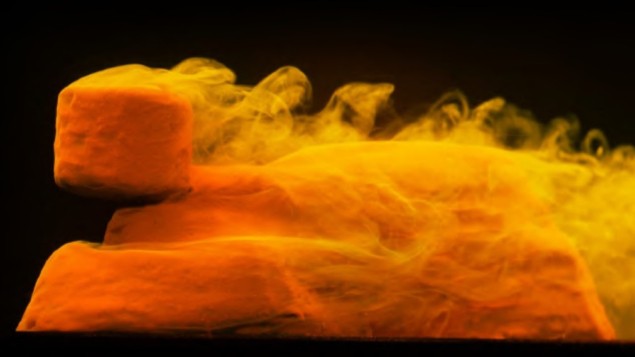
Much of the body of Egypt’s Great Sphinx could have been created by the natural erosion of a rock formation, according to researchers at New York University. The team used clay models to show that when outcrops of inhomogeneous rock are weathered by airborne sand, they can begin to resemble sitting lions. The research suggests that one of these landforms could have been modified by the ancient Egyptians to create the famous Sphinx.
The Great Sphinx is a monumental statue depicting a sitting lion with a human head thought to be that of a pharaoh. Taller than four double-decker buses, it is one of the most famous sculptures on the planet and was built four and a half thousand years ago. Whereas the nearby pyramids were built from stone blocks that were transported across the desert, the Sphinx was carved in one piece from a spur in the limestone bedrock.
Fierce debates continue to rage over whether geological processes played a part in the initial shaping of the iconic monument. This is because the abrasive wind in deserts like the Sahara can carve rocks into complex structures known as yardangs, which often look like animals or humans. In their study, Leif Ristroph, Samuel Boury and Scott Weady had the initial aim of studying the fluid mechanics of yardang formation. Ristroph says that they discovered the potential link to the Sphinx by accident.
Connection “screamed out”
“It was through work on erosion that we came upon yardangs as interesting test subjects. From there, it was really the lab experiments themselves that screamed out the possible connection to the Sphinx.“
Yardangs are formed from landforms that contain both soft and hard rock – which means that these structures erode in an inhomogeneous manner. As a result, the shape of the rock evolves continuously as well as the size and this makes it difficult to understand the conditions that cause yardangs to form.
To investigate the riddle of yardang formation, the researchers designed an experiment that would allow them to observe decades of erosion in just a few hours. The yardangs were modelled by clay mounds and weathering by the desert wind was represented by flowing water.
To simulate inhomogeneous erosion, the team embedded a squat plastic cylinder in the top of the mound, facing the incoming fluid. This cylinder stood in for a hard piece of rock. The researchers were surprised to see that once the cylinder was uncovered by erosion, the fluid sculped what looked like a neck, paws, and an arched back from the surrounding clay, with the cylinder forming a head (see figure). The final form bore a distinct resemblance to the Sphinx.
“Unexpected directions”
“I’m always excited by the unexpected directions that research takes us, and this project is a perfect example.” says Ristroph. The link to the Sphinx is supported by evidence that the top part of the Egyptian statue, which forms the head, is made from harder limestone than the neck.

Did slippery sand help Egyptians build the pyramids?
Inspired by their initial results, the researchers did an additional experiment to understand how fluid mechanics sculpted their Sphinx-like object. They built a clay-covered plastic model from 3D scans of the eroded object and used fluorescent dye to create streamlines of fluid. They observed that the plastic cylinder funnelled the water downwards, concentrating the erosion below the head and carving out the neck of the sphinx, leaving the lower part of the model to form the paws.
Commenting on the research, Alban Sauret, a fluid mechanics expert at University of California, Santa Barbara told Physics World that the study does not prove that the Sphinx was carved by nature. However, Sauret, who was not involved in the research, says, “Definitely they show that complex fluid patterns could lead to very intriguing formations. So, in itself, that’s a beautiful study.”
The team does not claim to have definitively solved the mystery of the Sphinx. But it does speculate that whether or not the creature’s body was sculpted by erosion, Sphinx-like structures would have formed in conditions common in Egypt. The work introduces the intriguing possibility that inspiration for the famous monument could have come from the desert itself.
The research is described in Physical Review Fluids
- SEO Powered Content & PR Distribution. Get Amplified Today.
- PlatoData.Network Vertical Generative Ai. Empower Yourself. Access Here.
- PlatoAiStream. Web3 Intelligence. Knowledge Amplified. Access Here.
- PlatoESG. Carbon, CleanTech, Energy, Environment, Solar, Waste Management. Access Here.
- PlatoHealth. Biotech and Clinical Trials Intelligence. Access Here.
- Source: https://physicsworld.com/a/did-natural-erosion-help-carve-egypts-great-sphinx/
- :has
- :is
- :not
- 160
- 2023
- 3d
- 8
- a
- accident
- According
- across
- Additional
- ago
- aim
- AL
- allow
- always
- an
- Ancient
- and
- animals
- ARE
- AS
- At
- back
- BE
- beautiful
- because
- been
- begin
- below
- Blocks
- body
- both
- boundary
- build
- built
- but
- by
- california
- came
- CAN
- captures
- carved
- Cause
- claim
- come
- Common
- complex
- conditions
- connection
- contain
- continue
- continuously
- could
- create
- created
- Current
- debates
- decades
- depicting
- described
- DESERT
- designed
- DID
- difficult
- discovered
- distinct
- does
- Egypt
- embedded
- entered
- evidence
- evolves
- example
- excited
- experiment
- experiments
- expert
- facing
- famous
- few
- Figure
- final
- flow
- Flowing
- fluid
- For
- form
- formation
- formed
- forms
- four
- from
- great
- had
- Half
- Hard
- harder
- Have
- head
- help
- HOURS
- How
- However
- HTML
- HTTPS
- human
- Humans
- iconic
- image
- in
- Incoming
- information
- initial
- Inspiration
- interesting
- into
- intriguing
- Introduces
- investigate
- involved
- issue
- IT
- itself
- jpg
- just
- known
- lab
- laboratory
- layer
- lead
- leaving
- like
- LINK
- Look
- look like
- looked
- lower
- made
- MAKES
- manner
- max-width
- means
- mechanics
- model
- models
- modified
- monumental
- most
- Mystery
- Natural
- Nature
- New
- New York
- NYU
- object
- observe
- of
- often
- on
- once
- ONE
- or
- out
- over
- part
- patterns
- PAWS
- perfect
- Physics
- Physics World
- piece
- planet
- plastic
- plato
- Plato Data Intelligence
- PlatoData
- played
- possibility
- possible
- potential
- processes
- project
- Prove
- Rage
- really
- region
- represented
- research
- Research suggests
- researchers
- result
- Results
- review
- Rock
- SAND
- Santa
- says
- scott
- sculpted
- see
- Shape
- shaping
- show
- Sitting
- Size
- So
- Soft
- some
- STONE
- streamlines
- structures
- Study
- Studying
- Suggests
- Supported
- Surface
- surprised
- Surrounding
- takes
- team
- test
- than
- that
- The
- their
- Them
- themselves
- There.
- These
- they
- this
- thought
- thousand
- Through
- thumbnail
- time
- to
- told
- top
- true
- tunnel
- uncovered
- understand
- Unexpected
- university
- University of California
- upon
- us
- used
- very
- was
- Water
- we
- WELL
- were
- What
- when
- whereas
- whether
- which
- WHO
- wind
- with
- Work
- world
- would
- years
- york
- zephyrnet













